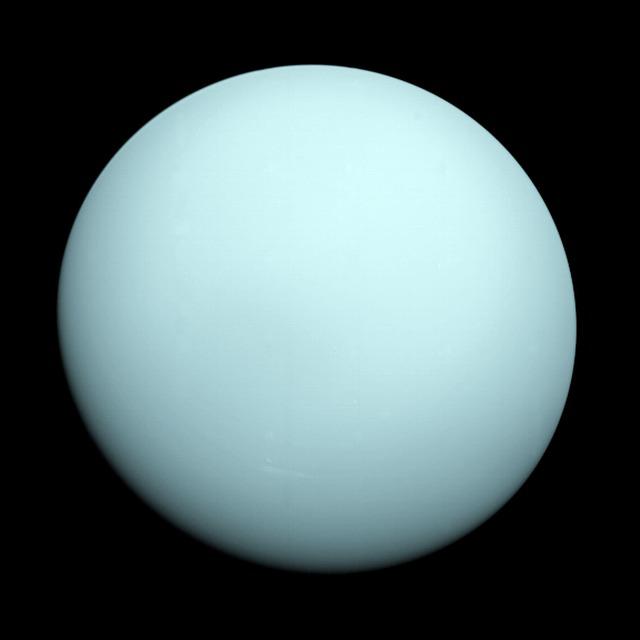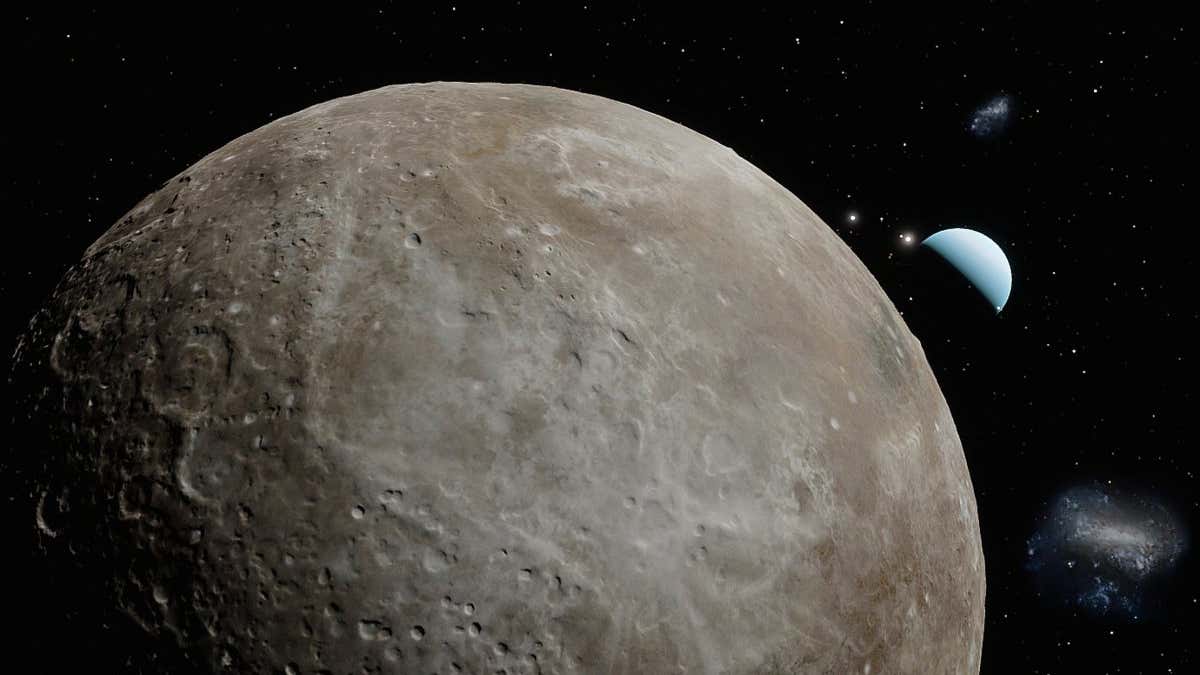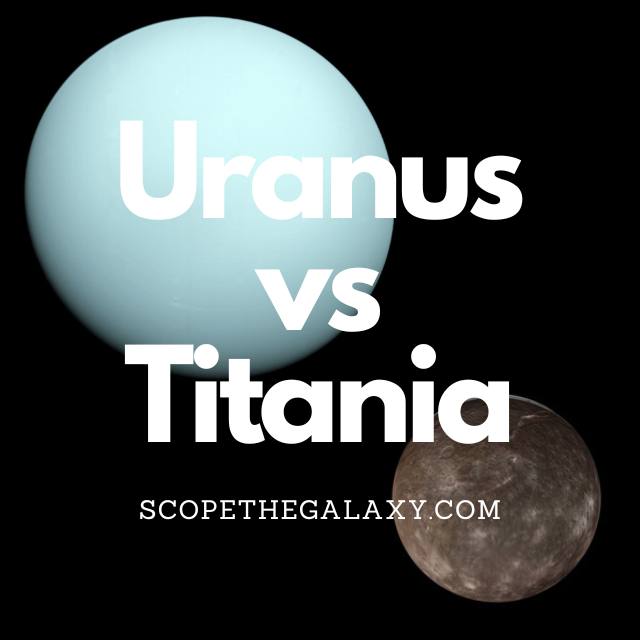*This post may contain affiliate links. This means we may make a commission if you purchase an item using one of our links*
The main differences between Uranus and Titania are that Titania is a natural satellite while Uranus is a gas giant planet, Titania is tidally locked to Uranus while Uranus is not tidally locked to anything, Uranus has one of the most drastic axial tilts in of 98 degrees while Titania’s axial tilt is practically 0 and Uranus has a magnetosphere while Titania has no magnetic field.
There are various other differences between the two so continue reading for a more detailed breakdown on both entities along with their similarities and differences below.
What Is The Planet Uranus?
Table of Contents

Uranus is the 7th farthest planet from the Sun and the 3rd largest planet in our solar system, coming in at a diameter of 50,724 km. This means that roughly 63 Earth’s could fit inside this ice giant.
In regards to why this cyan blue planet is referred to as an ice giant, it’s down to it’s composition. Uranus is made mostly of methane, ammonia and water with its atmosphere mostly consisting of hydrogen and helium, much like the Sun, and the other giant planets in our solar system.
Due to its distance from the Sun, it takes Uranus 84 years to complete one orbit our central star, whereas it’s axial rotation is much faster than even our Earth at 17 hours per rotation.
As a result of its distance from the Sun, ice based composition and faster rotation levels, Uranus is far from an ideal place to live in let alone have the potential to support life.
Its base temperature is generally a chilling -190 to -200 degrees Celsius and its rocky core, although hot, is still on the cooler side for a large planet sitting around the 5,000 degrees Celsius range.
The planet’s winds are also very fast often hitting 900 km/h, which is roughly twice that of Earth’s most powerful turbulent wind speeds.
In regards to the moons surrounding this cyan planet, we’ve discovered 27 small ones orbiting it. Furthermore, it has 13 rings surrounding it which also means Uranus has the most abundant collection of rings surrounding in our solar system, which is even more than Saturn.
One of the Uranus’ most unique features would include the manner in which it rotates around its axis. As opposed to the slightly angled rotation that the likes of Earth, Saturn and most other planets display, Uranus’ axis is positioned at a 98 degree angle.
What this means is this ice giant completes an axial rotation on its side as opposed to the relatively up straight positioning of most of the other planets in our solar system
What Is The Moon Titania?

Titania is the biggest of Uranus’s moons, with a circumference of 4,956km and a diameter of 1576.8km.
The high density of this moon suggests that it most likely formed from a collection of dust and debris leftover from the formation of Uranus or from the debris created in the collision that reportedly tilted Uranus onto its side. As a result Titania has a mass of 3.4 × 10^21 kg.
First discovered on 11th January 1787 (the same day as the discovery of Oberon, the second biggest moon of Uranus) by British astronomer William Herschel, the name “Titania” comes from the Shakespeare play, A Midsummer Night’s Dream. (Most of Uranus’ moons are named after Shakespeare’s characters.)
Having observed Titania for many years, scientists theorize that its composition is likely to be equal parts ice and rock, the latter of which may contain carbonaceous materials and organic compounds.
Research suggests that the moon most likely has a rocky core (accounting for 66% of the moon’s radius) and an icy mantle. If the mantle contains ammonia, it will act as antifreeze and make it possible for liquid water to exist. In this instance, the moon could possess a layer of liquid ocean around 50km thick.
Titania tilts slightly towards the equator of Uranus and is tidally locked to its planet. This means a Titania day is 8 days and 17 hours which would be the same for its orbital cycle. Titania has an average temperature of -203 degrees Celsius.
The planet Uranus is also tilted, with the moons orbiting on the equatorial plane, giving it extreme seasons. On Titania, the north and south poles experience 42 years of complete sunshine followed by 42 years of total darkness.
Scientists have observed the presence of large amounts of carbon dioxide, suggesting this may be the primary component of this moon’s atmosphere. Thanks to the tilted orbit, and a concentration of solar radiation from the poles, Titania probably maintains a carbon dioxide cycle, similar to the hydrogen cycle on Earth.
Similarities Between Uranus And Titania
There are a few similarities that Uranus and Titania share, which in this case includes the following:
- Both are a spherical shape.
- Both have a hotter core.
- Both are part of the same solar system.
- Neither have tectonic plates.
- Both orbit another object.
Differences Between Uranus And Titania
In regards to the differences between Uranus and Titania, it includes the below.
- Titania orbits Uranus whilst Uranus only orbits the Sun.
- Uranus has 13 rings surrounding it whilst Titania has 0.
- Uranus is an ice based gas giant whilst Titania is a terrestrial based natural satellite.
- Uranus has 27 moons whilst Titania has 0.
- Uranus has a diameter of 50,724km whilst Titania’s diameter is 1,576.8km.
- Titania has a very thin exosphere composed mostly of carbon dioxide whilst Uranus is gas based, composed mostly of hydrogen with smaller amounts of methane and helium.
- A day on Titania takes 8 days 17 hours whilst a Uranus day takes 17 hours.
- It takes Titania 8 days 17 hours to orbit Uranus and around the Sun in 84 years whilst Uranus only orbits the Sun in 84 years.
- Uranus has an axial tilt of 98 degrees whilst Titania’s axial tilt is closer to 0.
- Titania’s average temperature is around -203 degrees Celsius whilst Uranus has an average temperature of -190 to -200 degrees Celsius.
- Uranus has a density of 1.27 g/cm³ whilst Titania’s density is 1.71 g/cm³.
- Uranus’ mass is 8.681 × 10^25 kg whilst Titania’s mass is 3.4 × 10^21 kg.
- Titania’s gravitational strength is 0.367 m/s² whilst Uranus has a gravitational strength of 8.87 m/s².
- Titania is tidally locked to Uranus whilst Uranus is not tidally locked to any entity.
- Uranus has a magnetosphere whilst Titania does not.
- Titania may have water within its surface whilst around 80% of Uranus is made of icy materials.
Summary
Uranus and Titania don’t have too much in common other than the fact that both are part of the same solar system and that Titania orbits Uranus whilst being its biggest moon, but in regards to differences, they are quite vast.
Whether it be in regards to mass, size, length of day, axial tilt, the amount of moons that orbit them and more, therefore it does make sense that the two would have a lot of differences and functions distinctly from one another.

